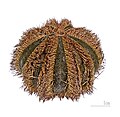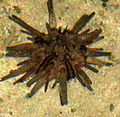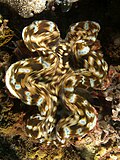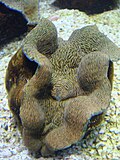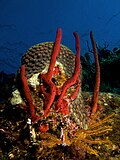bio.wikisort.org - Animal
This is a list of various species of marine invertebrates, animals without a backbone, that are commonly found in aquariums kept by hobby aquarists. Some species are intentionally collected for their desirable aesthetic characteristics. Others are kept to serve a functional role such as consuming algae in the aquarium. Some species are present only incidentally or are pest species.
This list is incomplete; you can help by adding missing items. (February 2011) |
Annelids
| Common name(s) | Image | Taxonomy | Reef safe | Care Level | Description | Max size |
|---|---|---|---|---|---|---|
| Christmas tree worm[1] |  | Spirobranchus giganteus | Yes | Expert | Found living anchored in live coral colonies in nature. Each worm has two crowns, which come in a variety of different colors, and are spiraled in the shape of a Christmas tree. | 5 cm (2.0 in) |
| Cluster duster[1] |  | Bispira brunnea | Yes | Moderate | This species grows in groups of up to 100 individual tube worms, living together in a single clump. The clusters of tubes adhere to a rocky substrate at a central point.[2] | 2.5 cm (1.0 in) |
| Feather duster worm, Fan worm[1] |  | Sabellastarte sp. | Yes | Easy to Moderate | A sedentary (but it can scoot around), tube dwelling worm with a fan-shaped crown (radiole) that projects from the end of the tube. This can be white, tan, orange, sometimes with striping. They build their tubes out of sand, mud, and bits of shell. | 20 cm (7.9 in) |
Arthropods
Cheliceratas
| Common name | Image | Taxonomy | Reef safe | Care Level | Description | Max size |
|---|---|---|---|---|---|---|
| Atlantic horseshoe crab |  | Limulus polyphemus | Yes, with caution | Easy | A bottom dwelling animal that is actually not a true crab. Found burrowing in mud or sand flats in the wild, they need a deep sand bed in their aquarium. | 60 cm (23.6 in) |
| Sea spider[3] |  | Pycnogonids | No | Not collected for the aquarium trade, but occasionally seen on live rock and corals as a hitchiker. They can be pests in a reef tank, preying on soft coral, sponges and anemones. | 0.2–50 cm (0.1–19.7 in) |
Crustaceans
Corals
Corallimorphs
| Common name(s) | Image | Taxonomy | Temperament | Care Level | Description | Max size |
|---|---|---|---|---|---|---|
| Jewel anemone |  | Corynactis viridis | ||||
| Knobbly mushroom coral, Florida false coral[4] |  | Ricordea florida | ||||
| Knobbly mushroom coral, Yuma mushroom coral[4] |  | Ricordea yuma | Semi-aggressive | Moderate | ||
| Mushroom coral, Mushroom anemone, Disk anemone[4] |  | Discosoma sp. | Semi-aggressive | Easy | ||
| Strawberry anemone |  | Corynactis californica |
Hydrocorals
| Common name | Image | Taxonomy | Temperament | Care Level | Description | Max size |
|---|---|---|---|---|---|---|
| Lace coral[5] |  | Distichopora sp. | ||||
| Fire coral[5] |  | Millepora sp. |
Large-polyp stony
| Common name(s) | Image | Taxonomy | Temperament | Care Level | Description | Max size |
|---|---|---|---|---|---|---|
| Black sun coral[6] |  | Tubastraea micrantha | Expert | |||
| Bubble coral |  | Plerogyra sinuosa | Aggressive | Easy | ||
| Candy cane coral |  | Caulastrea furcata | Peaceful | Easy | ||
| Elegance coral[7] |  | Catalaphyllia jardinei | Aggressive | Moderate | ||
| Flowerpot coral | 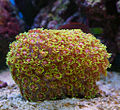 | Goniopora sp. | Aggressive | Difficult | ||
| Frogspawn coral[8] |  | Euphyllia divisa | Aggressive | Moderate | ||
| Hammer coral, Anchor coral[8] |  | Euphyllia ancora | Aggressive | |||
| Lobed brain coral |  | Lobophyllia hemprichii | Semi-Aggressive | |||
| Open brain coral |  | Trachyphyllia geoffroyi | Semi-aggressive | |||
| Pineapple brain coral, Moon coral | 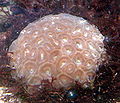 | Favia sp. | Aggressive | |||
| Sun coral, Orange cup coral[9] |  | Tubastraea sp., often Tubastrea aurea | Peaceful | Expert | ||
| Torch coral |  | Euphyllia glabrescens | Aggressive | |||
| Whisker coral, Duncan coral[10] |  | Duncanopsammia axifuga | Peaceful | Easy |
Small-polyp stony
| Common name | Image | Taxonomy | Temperament | Care level | Description | Max size |
|---|---|---|---|---|---|---|
| Pink bird's nest coral[11] |  | Seriatopora hystrix | ||||
| Cauliflower coral |  | Pocillopora sp., usually Pocillopora damicornis | ||||
| Dimpled encrusting Montipora |  | Montipora verrucosa | ||||
| Finger coral[12] |  | Montipora digitata and Montipora samarensis | ||||
| Millepora coral, "Milli" coral |  | Acropora millepora | Peaceful | Moderate | A popular and readily available species that comes in many color forms. It should not be confused with fire corals of the genus Millepora. | |
| Plating montipora |  | Montipora capricornis | Peaceful | Moderate | ||
| Staghorn coral[13] |  | Acropora cervicornis | Peaceful | Difficult | A very rare species, it is generally not available to the average hobby aquarist due to its critically endangered status. It would make a good aquarium specimen, but can only be obtained with a special license. |
Soft corals
| Common name(s) | Image | Taxonomy | Temperament | Care Level | Description | Max size |
|---|---|---|---|---|---|---|
| Cabbage leather coral |  | Sinularia brassica and Sinularia dura | Semi-aggressive | Easy | ||
| Clove polyps, Daisy polyps[14] |  | Clavularia sp | Peaceful | Easy | ||
| Devil's hand leather coral |  | Lobophytum sp. | Peaceful to Semi-aggressive | Easy | ||
| Finger leather coral |  | Sinularia sp. | Semi-aggressive | Easy | ||
| Jasmine polyps, Daisy polyps |  | Knopia | Peaceful | Easy | ||
| Pulse coral, Pulsing Xenia |  | Xenia sp. | Peaceful | Easy | An easy to care for coral known for its prolific asexual reproduction and polyps that actively move their tentacles in a pulsing motion. | |
| Red chili coral | 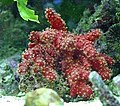 | Nephthyigorgia | Peaceful | Expert | ||
| Spaghetti leather coral | 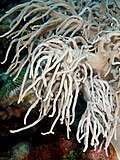 | Sinularia flexibilis | Semi-aggressive | Easy | ||
| Star polyps[14] |  | Clavularia viridis, Pachiclavularia viridis, or Briareum violaceum (taxonomy uncertain) | Peaceful | Easy |
Zoanthids
Echinoderms
Sea cucumbers
Starfish
Crinoids
| Common name | Image | Taxonomy | Reef safe | Care Level | Description | Max size |
|---|---|---|---|---|---|---|
| Feather star |  | Himerometra robustipinna |
Urchins
Jellyfish
Mollusks
Bivalves
Gastropods
| Common name | Image | Taxonomy | Reef safe | Care Level | Description | Max size |
|---|---|---|---|---|---|---|
| Abalone |  | Haliotis sp. | Yes | Easy | 12 cm (4.7 in) | |
| Arabian Cowrie |  | Cypraea arabica | 10 cm (3.9 in) | |||
| Astraea snail | Astraea sp. | Yes | Easy | 2.5–10 cm (1.0–3.9 in) | ||
| Bumble bee snail[15] |  | Engina mendicaria | Yes | Easy | 1.5 cm (0.6 in) | |
| Cerith snail | Cerithium sp. | Yes | Easy | 3.5 cm (1.4 in) | ||
| Gold ring cowrie |  | Cypraea annulus | 5 cm (2.0 in) | |||
| Lettuce sea slug |  | Elysia sp., usually Elysia crispata | Yes | Moderate | A sacoglossan sea slug with folded parapodia (side appendages), that give it a lettuce-like appearance. They feed on algae, and incorporate algal chloroplasts into their cells. Color ranges from brownish to green, and can include blues, yellows, and pinks. | 5 cm (2.0 in) |
| Nassarius snail |  | Nassarius sp. | Yes | Easy | 2.5 cm (1.0 in) | |
| Queen conch |  | Eustrombus gigas | Yes, but may knock over loose rocks and coral. | 30 cm (11.8 in) | ||
| Sand conch |  | Strombidae | ||||
| Sea Hare |  | Aplysiomorpha sp., usually Aplysia sp. or Dolabella sp. | Yes | Expert | 4–10 cm (1.6–3.9 in) | |
| Tiger cowrie, |  | Cypraea tigris | 15 cm (5.9 in) | |||
| Turbo snail | Turbo sp. | Yes | Easy | 5–10 cm (2.0–3.9 in) |
Cephalopods
Sea anemones
| Common name | Image | Taxonomy | Reef safe | Care Level | Description | Max size |
|---|---|---|---|---|---|---|
| Aptasia |  | Aiptasia sp. | No | A common pest species in marine aquariums which spreads rapidly and harms corals and invertebrates with their sting. Can sting fish, but fatalities are rare. Notoriously difficult to eradicate, but a number of organisms can be used for control, including peppermint shrimp and Berghia verrucicornis. | ||
| Bubble-tip anemone |  | Entacmaea quadricolor | With caution | Moderate | A relatively easy to keep anemone species, it is very colorful, and has distinctive bubble-like swellings on the tips of its tentacles. | 30 cm (11.8 in) |
| Condy anemone[16] | 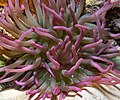 | Condylactis gigantea | With caution | Moderate | Common anemone species in the aquarium trade. The base color is usually brown to white, often with color on tentacle tips. Many color variations exist, including magenta, purple, yellow, and green. | 15 cm (5.9 in) |
| Delicate sea anemone[17] |  | Heteractis malu | With caution | Difficult | Also known as the malu anemone or white sand anemone. Color tipped tentacles reach 4 cm in length. This anemone should not be placed on a rock, it prefers a sandy substrate to bury its base in. | 20 cm (7.9 in) |
| Long tentacled anemone |  | Macrodactyla doreensis | With caution | Moderate | 50 cm (19.7 in) | |
| Magnificent anemone |  | Heteractis magnifica | With caution | Expert | One of the most difficult anemone species to keep healthy in captivity. | 1 m (3.3 ft) |
| Rock flower anemone |  | Phymanthus crucifer | With caution | Moderate | ||
| Tube anemone | 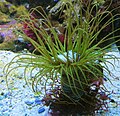 | Cerianthus sp. | Yes | Moderate | Not a true anemone (actinarian), but a member of the order Ceriantharia. Can make a very colorful aquarium specimen, colored with pinks, purples and sometimes shades of fluorescent green. |
Sponges
Tunicates
| Common name(s) | Image | Taxonomy | Reef safe | Care Level | Description | Max size |
|---|---|---|---|---|---|---|
| Blue lollipop tunicate[18] |  | Nephtheis fascicularis | Yes | Expert | 7.5 cm (3.0 in) | |
| Golden sea squirt, Ink-spot sea squirt[18] |  | Polycarpa aurata | Yes | Moderate | 15 cm (5.9 in) |
See also
- List of marine aquarium fish species
- List of marine aquarium plant species
- List of freshwater aquarium invertebrate species
- List of brackish aquarium invertebrate species
- Marine aquarium
- Reef aquarium
References
- Sprung, Julian (14 August 2002). "Aquarium Invertebrates: Featherdusters In The Aquarium". Advanced Aquarist. Pomacanthus Publications, LLC. Retrieved 14 December 2014.
- "Cluster Duster (Bispira brunnea)". AquariumDomain.com. AquariumDomain.com. Retrieved 14 December 2014.
- Goemans, Bob. "Marine Spiders (Sea Spiders)". saltcorner.com. Retrieved 26 November 2014.
- Sprung, Julian (14 October 2002). "Aquarium Invertebrates: Mushrooms, Elephants Ears, And False Corals: A Review Of The Corallimorpharia". Advanced Aquarist. Pomacanthus Publications, LLC. Retrieved 4 December 2014.
- Borneman, Eric. "Venomous Corals: The Fire Corals". Reefkeeping Magazine. Reef Central, LLC. Archived from the original on 3 November 2014. Retrieved 13 December 2014.
- de Vries, Joost (10 October 2012). "Tubastraea micrantha, the Black Sun, is the most majestic Azoox coral". Reef Builders. Reef Builders, Inc. Retrieved 10 December 2014.
- "Elegance Coral". FishChannel.com. I-5 Publishing, LLC. Retrieved 13 December 2014.
- Fatherree, James W. (3 October 2012). "Aquarium Corals: Corals of the Genus Euphyllia". Advanced Aquarist. Pomacanthus Publications, LLC. Retrieved 4 December 2014.
- Fatherree, James W. (14 December 2011). "Aquarium Corals: A Look at the Sun Corals". Advanced Aquarist. Pomacanthus Publications, LLC. Retrieved 4 December 2014.
- Hanley, Charles J. "Why Duncan, Your Whiskers are Tickling my Corallite!". QualityMarine.com. Quality Marine. Retrieved 13 December 2014.
- Thein, Than. "The Perfect Beginner SPS Coral: Seriatopora (Bird's nest)". Saltwater Smarts. Saltwater Smarts. Retrieved 13 December 2014.
- Dana Riddle. "Montipora digitata: A Stony Coral for All Hobbyists". Advanced Aquarist. VII (January 2008).
- "Staghorn Coral". Animal-World.com. Animal-World. Retrieved 13 December 2014.
- Fatherree, James W. "The Stoloniferans: Clove Polyps, Star Polyps, and Pipe Organ Corals". Saltcorner. Retrieved 4 December 2014.
- "Bumblebee Snail". Microcosm Aquarium Explorer. Microcosm, Ltd. Retrieved 23 November 2014.
- "Condy Anemone - Condylactis gigantea". Fishlore.com. Fish Lore.com. Retrieved 27 November 2014.
- "Delicate Sea Anemone". Animal-World.com. Animal-World. Retrieved 28 November 2014.
- Fatherree, James W. "An Introduction to Tunicates". Reefs.com. Reefs Magazine. Archived from the original on 14 December 2014. Retrieved 14 December 2014.
- Alderton, David (2005). Encyclopedia of Aquarium and Pond Fish (Second ed.). DK Publishing, Inc. pp. 286–297. ISBN 9780756636784.
- Lougher, Tristan (2008) [First Published 2007]. What Invertebrates?: A Buyer's Guide for Marine Aquariums. What Pet? Books Series. Barron's Educational Series, Inc. ISBN 978-0-7641-3741-9. LCCN 2006933016.
Текст в блоке "Читать" взят с сайта "Википедия" и доступен по лицензии Creative Commons Attribution-ShareAlike; в отдельных случаях могут действовать дополнительные условия.
Другой контент может иметь иную лицензию. Перед использованием материалов сайта WikiSort.org внимательно изучите правила лицензирования конкретных элементов наполнения сайта.
Другой контент может иметь иную лицензию. Перед использованием материалов сайта WikiSort.org внимательно изучите правила лицензирования конкретных элементов наполнения сайта.
2019-2025
WikiSort.org - проект по пересортировке и дополнению контента Википедии
WikiSort.org - проект по пересортировке и дополнению контента Википедии


































